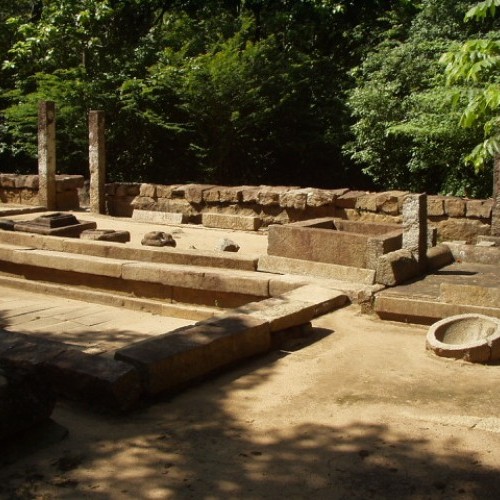Ritigala: Site Details
Forest Monastery and Cave Hermitage
Ritigala has an evocative location, with the steep, tree-clad mountain encircling the site like a giant green amphitheatre. Just past the entrance to the site lies the remains of the Banda Pokuna – a huge bathing pool lined with finely carved steps – which apparently fills with water during the monsoon. This possibly served a ritual purpose, with visitors bathing here before entering the monastery. At the far end of the tank, steep steps lead up to the beginning of the monastery’s main artery – an almost perfectly preserved stone walkway which, it is surmised, was originally built as a meditation walk for the resident monks since it runs through the forest and links all of the monastery’s main buildings.
Further along the walkway is a fine sequence of ‘double platform’ structures – two raised platforms aligned east to west and connected by a small stone “bridge” and surrounded by a miniature “moat” – which are typical of ancient Sri Lanka’s forest monasteries. It is presumed that the larger of the two platforms, usually bearing the remains of pillars, originally served as the base of a wooden building in which monks meditated individually in “cells”. Whereas the linked platform on the opposite side functioned as an open, communal meditation area. The “moat” was most likely filled with water and provided a natural form of air conditioning. A sunken courtyard nearby, usually described as the hospital, may have been an alms-house or bathhouse, with stone beds, stone oil baths and grinding stones.
The walkway continues to the urinal stones. Ritigala has none of the usual icons of a monastery or temple: no Bodhi tree, no relic house and no Buddha images. The only embellishments are on the urinal stones, which implies their purpose was not simply for urination. Most likely, the austere monks of the pamsukulikas would urinate on the elaborate iconographic stone carvings as a symbol of rebellion against the excesses of the monks at Anuradhapura.
Beyond here and further westwards, the walkway continues straight ahead to reach one of the “roundabouts” that punctuate its length. There has been much speculation about the original function of these roundabouts, including a rather quaint idea that they were designed to prevent meditating monks from walking into one another! A more prosaic explanation is that they supported open-air pavilions, designed to provide rest and shelter in the midday sun. Just before the roundabout, a path leads off to the right through enormous tree roots to what is often described as a fort, or more likely a lookout, reached by a stone bridge high above a stream, which offers particularly fine views over the surrounding forest.
Passed the roundabout are a couple of unexcavated platforms off the path to the left, which illustrate how the whole area must have appeared to HCP Bell when he first started exploring the site in 1893. Half a kilometer further on are two more sunken courtyards, the first of which contains a substantial double-platform structure, which is one of the largest buildings in the entire monastery. There are two steles (upright stone slabs) delimiting the left-hand side of the courtyard which, according to popular belief, monks would have paced between whilst practising walking meditation.











